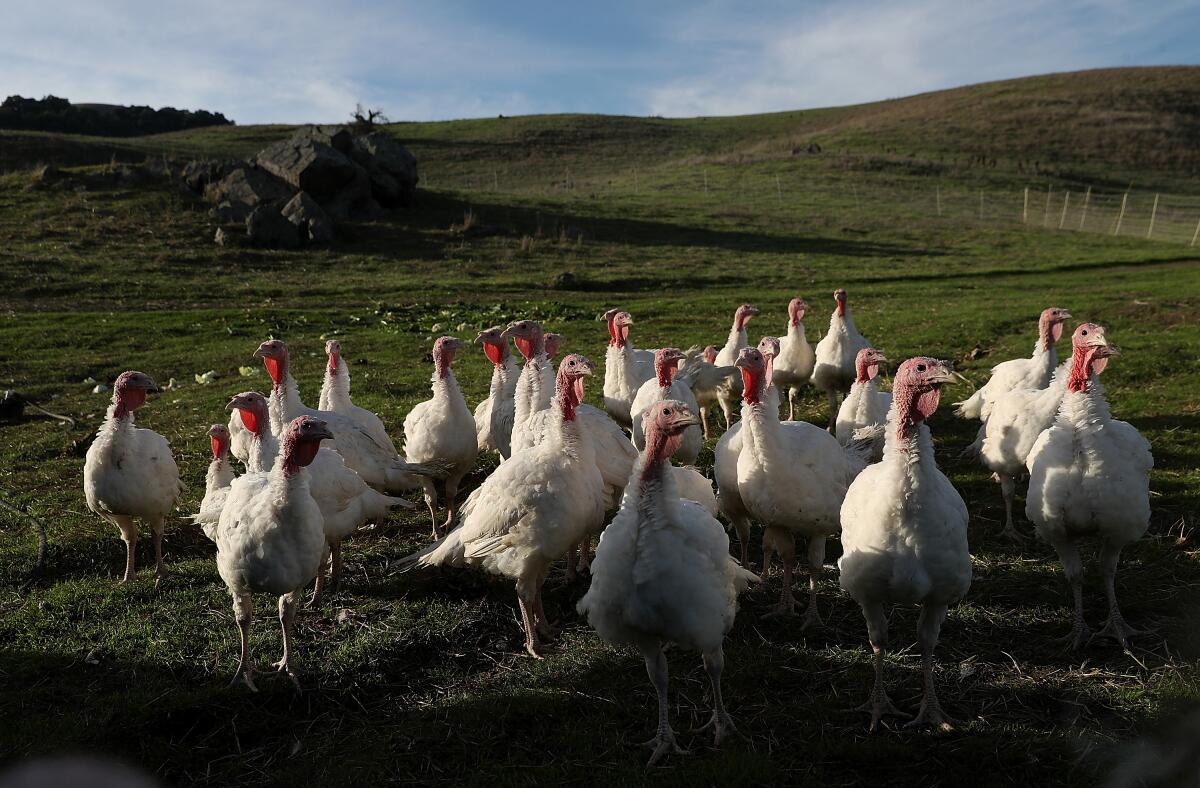With tiny turkeys in demand, sellers are getting creative. (One solution: turkey insurance)

- Share via
Americans prize colossal Thanksgiving turkeys — hulking burnished centerpiece beasts that make the dinner table groan.
Butcher Jered Standing can attest to that. Among his holiday memories from working in the Whole Foods meat department: donning a headlamp, climbing into a refrigerated trailer and digging through piles of 28- to 30-pounders, the ones he calls “dinosaur turkeys,” to appease shoppers in search of the fattest fowl.
But Thanksgiving gatherings will be smaller this year, and turkeys, too, are getting downsized. That’s affecting the entire supply chain as consumers, butchers, meat suppliers, grocers and chefs jostle to secure slender birds for the holiday, when a staggering 46 million are eaten. In many cases, it’s already too late: The little ones were spoken for long ago.
“Nine out of 10 people want the small birds,” said Standing, who now owns Standing’s Butchery in Hollywood. “I tried to get more — people are calling every day. They’re just not available.”
“We’re left with larger sizes,” said Yasser Elhawary of LA Fresh Poultry on Virgil Avenue. “A lot of people aren’t buying them because they’re not small enough. I try to tell them you can’t go wrong with leftovers — you can always make turkey breast sandwiches.”
To prevent their turkeys from becoming behemoths, farms that raise poults, as the young birds are known, slaughtered them weeks earlier than usual this year. Supermarkets have been adjusting their inventory to carry more modestly proportioned birds. Butchers are breaking down oversized turkeys and selling them in parts. And instead of whole-turkey dinners for large parties, restaurants are offering Thanksgiving takeout meals for two people; some are serving chicken or duck instead.

In pre-pandemic times, the turkeys at Tara Firma Farms in Petaluma would gorge on grass, bugs and fruit deep into autumn, free to balloon in size unchecked. Not so in 2020, when they were weighed frequently with an eye toward keeping most in the 10- to 15-pound range. The first batch of birds was processed on Oct. 26, as soon as they hit target weight.
“There were very few people who wanted an 18- to 20-pound turkey,” business manager Isabel Squire said. “Normally we’d process all of our turkeys the week before Thanksgiving so that they were fresh. Unfortunately, because we’re needing to be so specific about our sizing this year, the birds are going to be slightly frozen.”
Just 40% of the turkeys sold this month at Gelson’s have exceeded 16 pounds, down from 80% in a normal November, said Paul Kneeland, the grocery chain’s vice president of fresh operations.
“We’ve seen a significant shift to 10-to-16s,” he said. “We actually had to get more because our pre-orders for the smaller birds went way up.”
With COVID-19 cases soaring nationwide and officials urging people to celebrate with immediate family only, 70% of Americans are planning a Thanksgiving gathering with fewer than six people, according to Nielsen. That’s compared with 48% in 2019.
A general rule of thumb is 1 to 1.5 pounds of turkey meat per person, which means even a relatively scrawny 10-pounder will still be too big for many get-togethers. So turkey sellers are selling individual pieces in addition to whole birds.
“This was the first year I did parts, which is not usually something I’d do — I want the turkeys to come in whole and leave whole because that’s much, much easier,” Standing said. “But this time I asked for some big birds that we could cut up and do breasts and legs.”
At Butterball, a spokeswoman said the turkey brand in recent months “ramped up production” of several items, including bone-in and boneless breasts, to accommodate smaller groups.
Restaurants that are offering turkey pieces have seen huge demand. At All Day Baby, the individually smoked two-pound turkey legs ($19 per leg, intended to serve one or two people) sold out days before the $130 whole-smoked turkey for six to eight people. Co-owner Lien Ta began keeping a wait list, which had 32 names on it by the time she was able to secure more turkey legs on Wednesday.
If you have organically raised 12-to-14-pound turkeys and you want to sell them to Michael at Providence, you should reach out. This is a plea for 35 more turkeys.
— Chef Michael Cimarusti
That was also the case at Yang’s Kitchen in Alhambra, which quickly ran out of its Thanksgiving turkey leg dinners and was waiting to hear from its purveyors on how many more legs it could obtain.
“We may be able to offer additional dinners with a whole roasted chicken sub in place of the turkey legs,” the restaurant said in an Instagram story on Monday.
Turkeys destined for Thanksgiving are typically hatched over the summer, and retail buyers make purchasing decisions months in advance. Those who correctly predicted smaller pandemic-era holiday gatherings early had the best chance of being able to adjust their orders accordingly.
Gelson’s reached out in June to its usual turkey suppliers, Pitman Family Farms and Diestel Family Ranch, increasing its normal holiday order of small turkeys by 30%.
Two months later, when it had become clear that the pandemic was nowhere near under control, the Encino company called the farms back and asked for more turkeys and an even greater proportion of small ones. It also increased its inventory of turkey parts, doubling the amount of display space in the poultry sections at all 27 of its Southern California supermarkets to make room, Kneeland said.
Just how different this year’s Thanksgiving celebrations will be from years past is a matter for speculation. Two-thirds of Americans plan to celebrate in their own homes, up from 48% during the last three years on average, according to market research firm NPD Group. Some economists and farmers worry that scaled-back gatherings and tight personal finances could lead to lower sales for the $4.3-billion U.S. turkey industry.
Airports, train stations and rest stops are places where people are at risk of being exposed to the virus, and it can be difficult to stay six feet away from others, as health experts strongly recommend.
Others predict there might actually be a greater number of turkeys sold, a result of “more Thanksgiving tables but fewer people around them,” said Darren Seifer, NPD’s food and beverage industry analyst. Supermarket giant Kroger is betting that way, stocking more Thanksgiving turkeys at Ralphs and its other grocery chains, a spokeswoman said. Gelson’s estimates it will sell 30% to 40% more Thanksgiving turkeys than it did last year, when it sold 12,500.
One trend that pretty much everyone agrees on: With so many people staying home, next Thursday will see a lot of first-time Thanksgiving hosts, many of whom won’t want — or know how — to cook a feast that classically has a lot of dishes.
To entice nervous would-be cooks, Whole Foods got creative. Last week the chain announced that it had teamed with insurance company Progressive to offer a “Thanksgiving Protection Plan.” Shoppers who buy and take home a store-brand turkey by Sunday and go on to “commit a turkey cooking fail” — such as an overcooked, undercooked or burnt bird — are eligible to submit a claim; the first 1,000 to do so will get a $35 gift card.
Restaurants, which have been battered by months of indoor dining restrictions and other strict measures, also see an opportunity to step in and assist.
“We had to do something just to make some revenue and keep the business afloat,” said Michael Cimarusti, chef and co-owner of Providence on Melrose Avenue. “It’s as simple as that.”
The fine-dining restaurant is offering Thanksgiving takeout meals for the first time. The smaller option, designed to feed two or three diners, sold so quickly that Cimarusti called his meat guy back hoping for 50 more turkeys.
“He only had 15,” he said. “If you have organically raised 12- to 14-pound turkeys and you want to sell them to Michael at Providence, you should reach out. This is a plea for 35 more turkeys.”
Some restaurants aren’t even bothering with turkey, opting to sell to-go meals with naturally smaller birds or no poultry at all. In downtown, Orsa & Winston is doing a Thanksgiving dinner with duck for as few as two people; Manuela’s $100 “Thanksgiving Supper for 2” comes with a choice of turkey, ham or vegetarian pot pie.
In San Francisco, Birdsong also saw outsize demand for its small-party option.
“We’re doing two-, four- and six-people formats, and two has been the most popular,” accounting for 70% of orders, chef and co-owner Chris Bleidorn said. “It looks like it’s going to be a lot of personal, couples Thanksgivings.”
That won’t be true for everyone. A few farms said they were still fielding plenty of calls for large turkeys.
“I just took an order for a 26- to 28-pounder. So how many people do you think are getting together?” said Linda Gile, manager at the Willie Bird Turkeys store in Santa Rosa. “People are doing what they want to do. It is troubling, isn’t it?”
And although his days heaving massive supermarket turkeys are long behind him, Standing, too, will have at least one giant to contend with next week.
“A regular customer asked for a large bird this year the same way she did last year,” he said. “She wanted the ‘big mafia boss’ of turkeys.”
More to Read
Inside the business of entertainment
The Wide Shot brings you news, analysis and insights on everything from streaming wars to production — and what it all means for the future.
You may occasionally receive promotional content from the Los Angeles Times.










